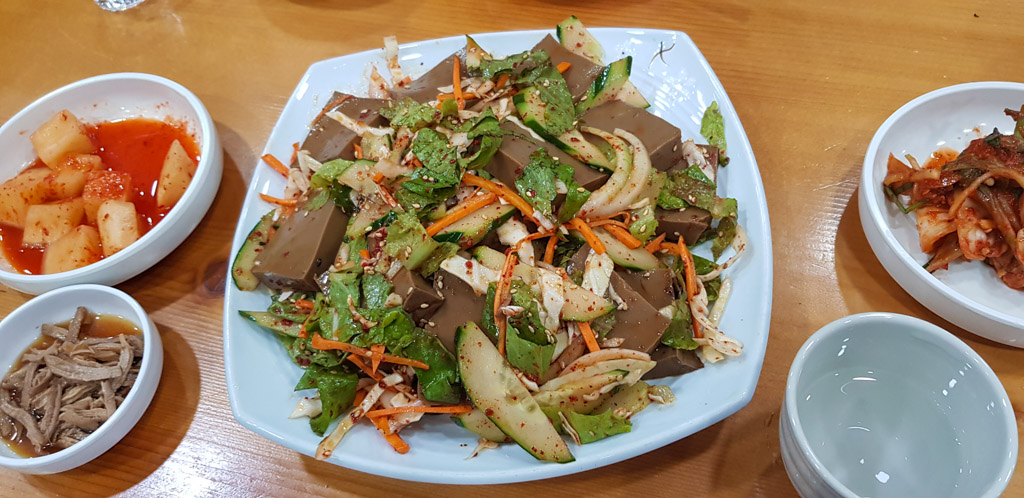Have you tried Baby Octopus Sashimi, Sea Pineapple and Makchang BBQ? Try to eat them in South Korea. If you dare.
1) Sannakji (산낙지)
Have you tried Korean Baby Octopus sashimi? Don’t worry: it is dead. The nerve system just doesn’t know it yet. The severed tentacles move freely on your plate and also in your mouth, where they attach themselves to the inside of your mouth. This feels very interesting. If you chew on it a few times, it stops and you can swallow the tentacle safely.
At Daecheon beach near Boryeong, I saw one of the cooks take the baby octopus out of the tank and slice it up right before serving. You can’t get fresher than that. Funnily enough, I didn’t even order sannakji: I ordered a different kind of sashimi and got the sannakji as a side dish.
If you are visiting Seoul, you can find sannakji at one of the fish markets, for example Noryangjin Fish Market.
2) Sea Pineapple (멍게)

Sometimes you stumble upon some very interesting food and you don’t know what it is. You can guess that it comes from the sea because the stall selling it is right next to the sea and you do recognize other objects in the fish tanks and bowls. So what do you do? You point at it and order it.
This is how I met a sea pineapple on Jeju Island and at many other fish markets in South Korea. A sea pineapple is a beautiful orange sea squirt that is most commonly eaten as sashimi in South Korea and Japan. If you look it up online you will see the flavor described as “something like iodine” and “rubber dipped in ammonia”. This seems pretty accurate and luckily they served it with some alcohol (Soju) and red pepper paste (Gochujang). You’ll need it! Combined with the peppery and burning taste, the flavor of the sea pineapple is somewhat neutralized. I did not like the taste and would not recommend it to anyone. However, you’ll have to agree with me that sometimes you just have to try the unknown, especially when it looks as intriguing as this sea pineapple.
3) Chicken Feet (닭발)

At Gwangjang Market in Seoul, you can try chicken feet. If you are from Asia, this may not seem very exotic to you, but for me, this is something I cannot order at home. Chicken feet are a little spicy and chewy with a bite. There are no bones in them. It can be a challenge for amateur chopstick users!
If you order from one of the restaurants in the market, you can also order Tteokbokki, Mung Bean Pancake and Gimbap and try many popular Korean street food snacks all at once!
4) Sea Cucumber (해삼)

Sea cucumbers are found worldwide at the bottom of the sea, but I doubt many people from my country are aware of it. A sea cucumber has an elongated body and a leathery skin. You can buy them in most fish markets and they are on the menu in Chinese restaurants in South Korea. It was one of those things I saw everywhere, didn’t know the name of, and ended up ordering randomly from a photo. Combined with pork belly in one dish, the sea cucumber by itself didn’t have a very strong flavor. Do try this one!
5) Makchang (막창)

Instead of pork belly, you can also grill pork intestines on the Korean BBQ. This is called Makchang and the city Daegu is famous for it. You can find many Korean BBQ restaurants serving Makchang near Anjilang (안지랑), a street in Daegu filled with restaurants specialized in Makchang. It is a bit out of the way, but don’t worry: most Korean BBQ restaurants around Dongseong-ro also serve Makchang. You can often also order samgyeopsal (grilled pork belly) if you or one of your party prefers to eat something else.
6) Dotorimuk Acorn Jelly (도토리묵)

Dotorimuk is a jelly made from acorn starch. It is often eaten as a side dish, seasoned and mixed with other ingredients such as carrots and sesame, garlic, soy sauce, sesame oil, red chili pepper powder, and sesame seeds. This is necessary because the acorn jelly does not have an interesting flavor by itself; but it does charm you into trying it at least once with its smooth flubby texture.
Now you also know what the little brownish cubes or slices are called that you sometimes get as a side dish. If the jelly is white in color, it is made from mung beans; if it is light brown, it may be made from buckwheat or acorn starch.
Have these dishes left a bitter taste in your mouth? Then look for Korean desserts or sweet snacks to restore the balance.







